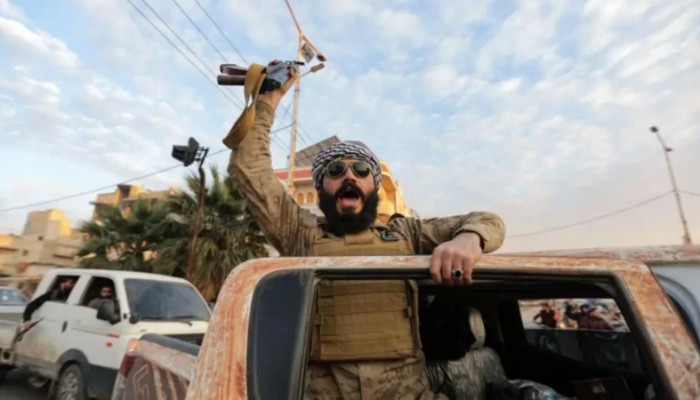Syrian rebels begin to encircle Damascus amid denials Assad has fled
 Opposition factions overrun government forces and take control of swathes of district outside the capital The advance came just a week after Islamist insurgents led by Hayat Tahrir al-Sham (HTS) retook Aleppo in northern Syria, inspiring rebel factions all across the country to rise up against the Syrian army. Syrian state media reported that government forces were concentrating on stopping HTS’s advance in Homs, carrying out heavy airstrikes on rebel forces there and sending reinforcements to the central Syrian city. If Homs was to fall to rebels, the government would be besieged in Damascus. Opposition forces would be advancing from the north, south and east of the country. The government in neighbouring Iraq said that 2,000 Syrian soldiers had fled across the border. Al Jazeera showed footage of Syrian tanks and other military vehicles packed with soldiers crossing into Iraq. Russia and Iran, which provided the bulk of military and financial support to the Assad government during Syria’s 2011 revolution-turned-civil war, have seemed unwilling to lend support to its ally since the beginning of the rebel operation last week. Hezbollah, the pro-Iran group whose fighters used to bolster the ranks of the Syrian army, has been unable to send a significant number of fighters to help, following the heavy losses it recently incurred against Israel. In an interview with Iraqi media on Friday, the Iranian foreign minister, Abbas Araghchi, said that while the “resistance would do its duty”, it was impossible to predict the fate of Assad. Similarly, the secretary general of Hezbollah, Naim Qassem, said in a speech on Thursday that the group would stand with Assad, but has yet to provide tangible support to the isolated leader. Without significant Russian air support and Hezbollah reinforcements, Syrian army forces have seemingly melted away in the face of the advancing rebels. Rebel leaders have called upon government forces to defect instead of fighting. “The clashes have been limited to just a few points to pressure regime forces to surrender, with assurances that they would be safe and with emphasis that in the end, we are all sons of one country,” said Yasser al-Mikdad, an officer in the Operations Room for the Liberation of Damascus, an umbrella organisation for opposition forces in southern Syria. The military officer described the taking of the town of Moadamiya in the western countryside of Damascus – just a few miles from the Republican Palace – where he said most government forces withdrew ahead of the advancing rebels, leaving only 70 Syrian army soldiers. “Instructions were issued to our groups not to engage them and to try to convince them to surrender in order to avoid bloodshed,” al-Mikdad said. In areas newly seized by the rebels they rejoiced over their victory, with videos showing a statue of the late Syrian president Hafez al-Assad being toppled, and its head tied to a motorcycle and dragged through the road. In videos that were unable to be independently verified, regime police officers stripped off their uniforms in the middle of the street and walked away in civilian clothing. As rebels swept through towns and cities, they opened the doors to government prisons, notorious for torture. Crowds met dazed-looking detainees, some of whom had been imprisoned for decades, as they stepped outside for the first time in years. In Damascus, residents described scenes of panic as uncertainty reigned over the fate of the Syrian government as rebels beat on the capital’s door. One resident of Damascus, who didn’t want to be identified, said: “Those who have residencies in Lebanon are leaving, lots are fleeing. We ourselves, we could leave, but things are happening so quickly. Maybe we start to get ready and gather our things and leave, and maybe something happens and we get stuck, nothing is clear.” Syrian state media denied rumours that Assad had fled the capital. “The presidency of the Syrian Arab Republic also confirms that Mr President continues his work and national and constitutional duties from the capital, Damascus,” Assad’s office said in a statement. The dizzying pace of events in Syria and the uncertainty over the fate of the Assad government in Syria has left international powers reeling and prompted questions over its geopolitical ramifications. Assad was a key ally of Hezbollah and an important supplier for the group, which receives much of its resources from Iran via Iraq and Syria. Millions of Syrians who fled the violence of the civil war and the government’s bloody crackdown on protests in 2011, also watched the rebel advance anxiously, waiting to see if they might be able to safely return to the country after more than 13 years in exile. |

The Walt Disney Company and OpenAI reach landmark agreement to bring beloved characters from across Disney’s brands to Sora
42511.12.2025, 21:48
Miss Finland stripped of crown following apparent racist gesture (photo)
50911.12.2025, 17:35
Trump launches gold card program for expedited visas with a $1 million price tag (photo)
42411.12.2025, 13:11
«Demand from your city authorities the AIR your children are entitled to-it is a vital necessity»: Kristina Vardanyan (photo)
60510.12.2025, 18:47
Hamas source to ToI: We’ll hold talks on disarming, but we can’t be forced to give up guns
63609.12.2025, 23:17
Exclusive: Armenia and Azerbaijan representatives come together publicly in Euronews interview (video)
62709.12.2025, 21:47
